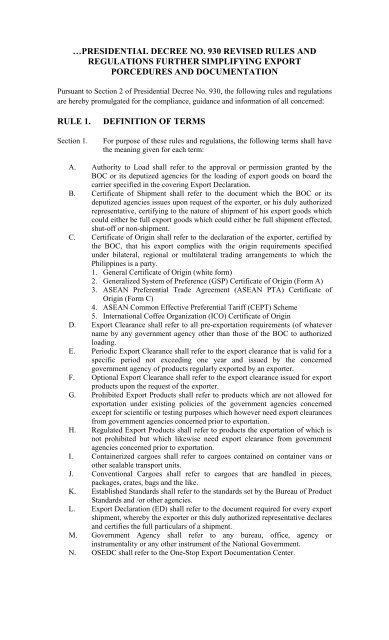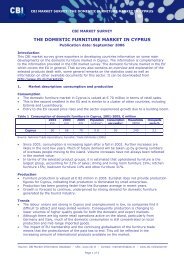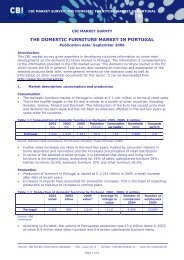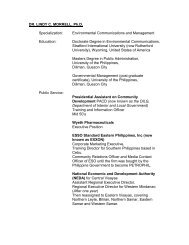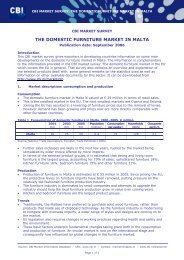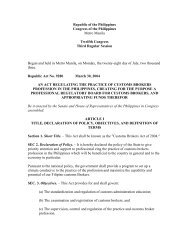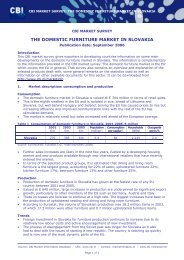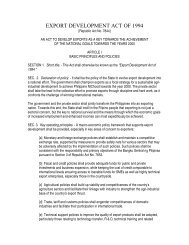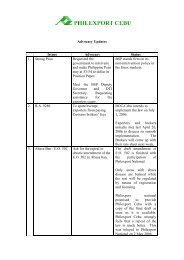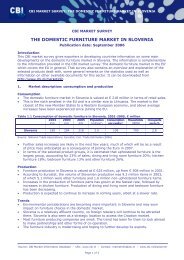presidential decree no. 930 revised rules and ... - Philexport Cebu
presidential decree no. 930 revised rules and ... - Philexport Cebu
presidential decree no. 930 revised rules and ... - Philexport Cebu
Create successful ePaper yourself
Turn your PDF publications into a flip-book with our unique Google optimized e-Paper software.
…PRESIDENTIAL DECREE NO. <strong>930</strong> REVISED RULES AND<br />
REGULATIONS FURTHER SIMPLIFYING EXPORT<br />
PORCEDURES AND DOCUMENTATION<br />
Pursuant to Section 2 of Presidential Decree No. <strong>930</strong>, the following <strong>rules</strong> <strong>and</strong> regulations<br />
are hereby promulgated for the compliance, guidance <strong>and</strong> information of all concerned:<br />
RULE 1.<br />
Section 1.<br />
DEFINITION OF TERMS<br />
For purpose of these <strong>rules</strong> <strong>and</strong> regulations, the following terms shall have<br />
the meaning given for each term:<br />
A. Authority to Load shall refer to the approval or permission granted by the<br />
BOC or its deputized agencies for the loading of export goods on board the<br />
carrier specified in the covering Export Declaration.<br />
B. Certificate of Shipment shall refer to the document which the BOC or its<br />
deputized agencies issues upon request of the exporter, or his duly authorized<br />
representative, certifying to the nature of shipment of his export goods which<br />
could either be full export goods which could either be full shipment effected,<br />
shut-off or <strong>no</strong>n-shipment.<br />
C. Certificate of Origin shall refer to the declaration of the exporter, certified by<br />
the BOC, that his export complies with the origin requirements specified<br />
under bilateral, regional or multilateral trading arrangements to which the<br />
Philippines is a party.<br />
1. General Certificate of Origin (white form)<br />
2. Generalized System of Preference (GSP) Certificate of Origin (Form A)<br />
3. ASEAN Preferential Trade Agreement (ASEAN PTA) Certificate of<br />
Origin (Form C)<br />
4. ASEAN Common Effective Preferential Tariff (CEPT) Scheme<br />
5. International Coffee Organization (ICO) Certificate of Origin<br />
D. Export Clearance shall refer to all pre-exportation requirements (of whatever<br />
name by any government agency other than those of the BOC to authorized<br />
loading.<br />
E. Periodic Export Clearance shall refer to the export clearance that is valid for a<br />
specific period <strong>no</strong>t exceeding one year <strong>and</strong> issued by the concerned<br />
government agency of products regularly exported by an exporter.<br />
F. Optional Export Clearance shall refer to the export clearance issued for export<br />
products upon the request of the exporter.<br />
G. Prohibited Export Products shall refer to products which are <strong>no</strong>t allowed for<br />
exportation under existing policies of the government agencies concerned<br />
except for scientific or testing purposes which however need export clearances<br />
from government agencies concerned prior to exportation.<br />
H. Regulated Export Products shall refer to products the exportation of which is<br />
<strong>no</strong>t prohibited but which likewise need export clearance from government<br />
agencies concerned prior to exportation.<br />
I. Containerized cargoes shall refer to cargoes contained on container vans or<br />
other sealable transport units.<br />
J. Conventional Cargoes shall refer to cargoes that are h<strong>and</strong>led in pieces,<br />
packages, crates, bags <strong>and</strong> the like.<br />
K. Established St<strong>and</strong>ards shall refer to the st<strong>and</strong>ards set by the Bureau of Product<br />
St<strong>and</strong>ards <strong>and</strong> /or other agencies.<br />
L. Export Declaration (ED) shall refer to the document required for every export<br />
shipment, whereby the exporter or this duly authorized representative declares<br />
<strong>and</strong> certifies the full particulars of a shipment.<br />
M. Government Agency shall refer to any bureau, office, agency or<br />
instrumentality or any other instrument of the National Government.<br />
N. OSEDC shall refer to the One-Stop Export Documentation Center.
RULE II.<br />
EXPORT CLEARANCES<br />
Section 1.<br />
Section 2.<br />
Section 3.<br />
Section 4.<br />
Per Shipment Export Clearances issued by specified government<br />
agencies shall be required for prohibited products <strong>and</strong> regulated<br />
products (listed in Annex A).<br />
Periodic Export Clearances – Specified government agencies may<br />
grant periodic export clearances to exporter, the validity period of<br />
which is to be determined by said agencies, provided such period<br />
shall <strong>no</strong>t exceed one year. Each of the offices/agencies concerned<br />
shall formulate, prescribe <strong>and</strong> promulgate guidelines governing the<br />
issuance of such periodic clearances. The guidelines shall include,<br />
among others, the basis for determining the validity periods of<br />
clearances to be issued, <strong>and</strong> criteria for determining <strong>and</strong> identifying<br />
regular exporters entitled to such periodic export clearances.<br />
Optional Export Clearances may be issued upon request of the<br />
exporter for products (enumerated in Annex B).<br />
Additional Products – No new products shall be added to Annex<br />
A, without the prior approval of the Inter-Agency Committee<br />
(IAC) on E.O. 1016. For this purpose, The Department of Trade<br />
<strong>and</strong> Industry shall conduct a review, at least one a year in<br />
consultation with appropriate government agencies of the list in<br />
said annex A for the possible additions <strong>and</strong> deletions <strong>and</strong> shall<br />
submit its recommendations thereon to said committee.<br />
RULE III. PROCEDURES FOR SECURING EXPORT<br />
CLEARANCES<br />
Section 1. Per Shipment Export Clearances – The exporter shall submit one<br />
set of the Export Clearance form, together with the other required<br />
documents to the concerned government agency.<br />
Upon receipt of the accomplished Export Clearance from, the agency<br />
concerned shall undertake the following:<br />
a. Check if the papers are in order.<br />
b. Assign an inspector/analyst to inspect the product <strong>and</strong> obtain samples for<br />
analysis, if necessary:<br />
c. Collect fees, if any is due;<br />
d. Issue clearance in two (2) copies to the exporter.<br />
The exporter shall then proceed to the BOC to obtain the Authority to Load in<br />
accordance with the procedures provided in Rule VII hereof.<br />
Section 2. Periodic clearance – Exporters who wish to secure the periodic export<br />
clearance shall apply in writing with the government agency concerned<br />
which shall evaluate the applications in accordance with Section 2, Rule<br />
II, of these Rules <strong>and</strong> Regulations.<br />
Section 3. Additional Clearances – No new export clearances shall be imposed<br />
without the prior approval of the IAC on EO 1016.<br />
RULE IV.<br />
STANDARDIZATION AND INSPECTION<br />
RESPONSIBILITIES OF GOVERNMENT<br />
COMMODITY OFFICES.<br />
This shall be governed by Section 4 of PD <strong>930</strong> as amended<br />
by EO 1016.
RULE V.<br />
INSPECTION FEES<br />
No new <strong>and</strong> additional fees/charges shall be imposed by the<br />
government agencies concerned with inspection of export products<br />
except as provided for?<br />
RULE VI. THE EXPORT DECLARATION (ED)<br />
Section 1.<br />
Section 2<br />
Submission of Export Declaration – As soon as the exporter is<br />
ready to ship his goods, he shall secure an Export Declaration (ED)<br />
form any of the following:<br />
DTI/BOC/OSEDC/EDC/BSP/PHILEXPORT <strong>and</strong> accomplish the<br />
same.<br />
Filing of Export Declaration Form – the exporter shall file all<br />
copies of the accomplished ED directly with the BOC or its<br />
deputized agencies or OSEDC for processing <strong>and</strong> approval through<br />
the issuance of the Authority to Load. The BOC shall assign the<br />
ED number to the form.<br />
The exporter shall accomplish the ED from in four (4)) clear<br />
copies to be segregated as follows: BOC copy (original),<br />
Exporter’s copy, National Statistics Office (NSO) copy, <strong>and</strong> DTI<br />
copy.<br />
RULE VII. RESPOSIBILITIES OF THE BUREAU OF<br />
CUSTOMS<br />
The BOC shall be responsible for the issuance of:<br />
a. Authority to Load<br />
b. Special Permit to Load<br />
c. Certificate of Origin; <strong>and</strong><br />
d. Post-loading Certificates<br />
RULE VIII.<br />
AUTHORITY TO LOAD<br />
Section 1. Where to File Request – Exporters may file the request with any of<br />
the following export processing units of the BOC:<br />
a. For Manila Loading:<br />
- The Export Division of the Port of Manila (POM), the Manila<br />
International Container Port (MICP) or the Ni<strong>no</strong>y Aqui<strong>no</strong><br />
International Airport (NAIA).<br />
- The OSEDC for loading at any of the above ports.<br />
- The BOC Unit at the Garments <strong>and</strong> Textile Export Board (GTEB-<br />
BOC Unit) for GTEB controlled exports for loading at any of the<br />
above ports.<br />
b. For Provincial Loading:<br />
- The BOC Export Division or the OSEDC at the port of loading.<br />
- The BOC Export Coordination Division under the Office of the<br />
Commissioner.<br />
Section 2. Documents to be submitted – The following documents shall be submitted:<br />
a. Export Declaration. Enterprises <strong>no</strong>t registered with either the Board of<br />
Investment (BOI) or Philippine Eco<strong>no</strong>mic Zone Authority (PEZA) shall affix<br />
the required BOC/Bureau of Internal Revenue (BIR) documentary stamps to<br />
the ED.<br />
b. Commercial Invoice if the ED is with foreign exchange proceeds.
c. For provincial loading, a written request for authority to load if the ED is filed<br />
at the Export Coordination Division (ECD). Request should indicate date <strong>and</strong><br />
port of loading, commodity, quality <strong>and</strong> value of exports.<br />
d. Export Clearance, if required.<br />
Section 3. Issuance of Authority to Load – After checking completeness, accuracy <strong>and</strong><br />
consistency of the documents, the export unit concerned shall authorize<br />
loading. The Authority to Load is indicated at Box 52 of the ED.<br />
Where the ED was processed at the ECD for provincial loading, a telegraphic<br />
instruction is sent to the Collector of Customs concerned. The telegram serves as<br />
basis for the Collector to issue an Authority to Load.<br />
Section 4. Loading of Shipment – The exporter shall present the ED to:<br />
a. Customs container Control Division (CCCD of Port of Manila or Manila<br />
International Container Port (MICP) or equivalent unit in provincial ports)<br />
if shipment is containerized. The CCCD shall then forward the EDs to the<br />
Arrastre Office for collection of arrastre charges <strong>and</strong> then to the Philippine<br />
Ports Authority (PPA) for clearance.<br />
b. Arrastre office if shipment is conventional from whence EDs are sent to<br />
the PPA for clearance.<br />
c. Appropriate units in NAIA if a shipment is by air.<br />
Section 5. The Inspector’s Report of Loading – After loading, the customs Inspector<br />
on board vessel or CCCD representative (containerized cargo) shall<br />
submit to the export unit concerned the original copy of the Inspector’s<br />
Report of Loading together with a copy of the EDs covered by the report.<br />
If the shipment is subject to duty drawback, a copy of the completely processed<br />
ED shall be submitted to the Tax Credit <strong>and</strong> Duty Drawback Center of the<br />
Department of Finance.<br />
RULE IX. THE SPECIAL PERMIT TO LOAD<br />
The Special Permit to Load shall be granted under the following circumstance:<br />
a. For authority to load locally transshipped goods to foreign vessel.<br />
b. For Shipments where the Export Declaration is <strong>no</strong>t required under the existing<br />
BSP <strong>rules</strong>; or<br />
c. For partial shipments covered by a Monthly General Export Declaration<br />
RULE X. THE CERTIFICATE OF ORIGIN<br />
Section 1.<br />
Certificate of Origin (CO) – The CO shall be issued to the exporter<br />
or his duly authorized representative.<br />
The BOC has the authority to verify the origin of products <strong>and</strong> other statements in the<br />
certificate.<br />
Section 2.<br />
Documents to be filed – The following documents shall be<br />
submitted:<br />
a. Certificate of Declaration;<br />
b. Export Declaration;<br />
c. Bill of Lading;<br />
d. Commercial Invoice ;<strong>and</strong><br />
e. Any appropriate supporting documents proving the products to be<br />
exported quality for the issuance of a CO.
Section 3.<br />
Issuance of the Certificate of Origin – In general, the unit which processed<br />
the ED issues the corresponding CO. However, for EDs processed at the<br />
GTEB-BOC Unit, COs are to be issued:<br />
- by ECD for shipmen by sea<br />
- by GTEB-BOC Unit for shipments by air<br />
- For COs to be issued by the BOC, the Export Coordination<br />
Division (ECD) also issues said COs for Export Declarations<br />
(EDs) processed in the OSEDC.<br />
Section 4.<br />
Section 5.<br />
Section 6.<br />
Section 7.<br />
Section 8.<br />
General Certificate of Origin (White Form) – This Certificate is issued<br />
upon request of the exporter for exports <strong>no</strong>t qualified for either the GSP or<br />
ASEAN PTA but is nevertheless required by the importing country. The<br />
original <strong>and</strong> duplicate copies are given to the exporters.<br />
The GSP Certificate of Origin (Form A) – This Certificate is issued for<br />
exports qualified for preferential tariff treatment under the ASEAN<br />
preferential Trade Agreement. The original copy is sent directly to the<br />
customs authority of the importing country.<br />
The ASEAN Preferential Trading Agreement (ASEAN PTA Form C) – This<br />
Certificate is issued for exports qualified for preferential treatment under<br />
the ASEAN preferential Trade Agreement. The original copy is sent<br />
directly to the customs authority of the importing country.<br />
The ASEAN Common Effective Preferential Tariff (CEPT) Scheme<br />
Certificate of Origin (ASEAN CEPT Form D) – This Certificate is issued<br />
for exports qualified under the tariff reduction programs of the SEPT<br />
scheme, the basic instruments used to implement ASEAN Free Trade Area<br />
(AFTA) Agreement.<br />
The International Coffee Organization (ICO) Certificate of Origin – This<br />
Certificate is issued for all coffee exports originating from the Philippines<br />
as prescribbed by the International Coffee Organization.<br />
RULE XI. POST LOADING CERTIFICATE<br />
Upon request of the exporter <strong>and</strong> after the carrier has departed, the export<br />
unit which processed the ED shall issue<br />
a. Certificate of Shipment/Non-shipment. This certificate is issued by the export<br />
unit based on the Inspector’s Report of Loading.<br />
b. Certificate of re-exportation for bond cancellation. This is also based on the<br />
Inspector’s Report of Loading.<br />
RULE XII. NEGOTIATIONS AND PAYMENT<br />
Section 1.<br />
When the shipment is <strong>no</strong>t fully prepaid – The exporter shall negotiate his<br />
bill of exchange/account with the AAB/OBUs together with the Bill of<br />
Lading/Airway bill, signed Commercial Invoice <strong>and</strong> such other documents<br />
as may be required by the buyer.<br />
The AAB concerned shall report to BSP the payment thereof in accordance with<br />
existing BSP <strong>rules</strong>.<br />
Section 2.<br />
When shipment is fully prepaid or an open account basis - The exporter<br />
may send the shipping documents mentioned in the proceeding section<br />
directly to the buyer, provided copies thereof are submitted to the<br />
AAB/OBUs, for record/monitoring purposes.
RULE XIII.<br />
STANDARDIZED EXPORT DOCUMENTS<br />
Section 1.<br />
Section 2.<br />
Export Documents – The following export documents, the facsimile of<br />
these re hereto attached <strong>and</strong> made an integral part hereof shall serve as<br />
st<strong>and</strong>ard forms to be used in the export of goods from the Philippines.<br />
a. Export Declaration, Annex A<br />
b. Export Clearance, Annex B<br />
c. Periodic Export Clearance, Annex C<br />
d. General Certificate of Origin, Annex D<br />
e. ASEAN PTA Certificate of Origin, Annex E<br />
f. ASEAN CEPT Scheme Certificate of Origin, Annex E<br />
g. ICO Certificate of Origin, Annex G<br />
Changes in Forms Not Allowed – No changes in the aforementioned forms<br />
especially in the contents, size <strong>and</strong> in the number of copies required herein<br />
shall be made without prior approval by the NEDA.<br />
RULE XIV. RESOLUTION OF ISSUES; APPEAL<br />
Section 1.<br />
Section 2.<br />
Resolution of Issues – The DTI shall have the authority to resolve<br />
any issues or conflict that may arise between or among government<br />
agencies resulting from the reassignment of inspection <strong>and</strong>/or<br />
certification authorities provided for the PD <strong>930</strong>.<br />
Appeal – any agency <strong>no</strong>t satisfied with the decision of the DTI may<br />
elevate the issue to the NEDA within fifteen (15) days form the<br />
receipt of <strong>no</strong>tice thereof, provided, that failure to elevate the<br />
issue/conflict within this period shall render the resolution of the<br />
DTI final <strong>and</strong> executor.<br />
RULE XV. GENERAL PROVISIONS<br />
Section 1.<br />
Section 2.<br />
Section 3.<br />
Section 4.<br />
Section 5.<br />
Section 6.<br />
Administration – The DTI shall be responsible for coordinating the<br />
administration <strong>and</strong> implementation of the provision of the PD <strong>930</strong><br />
<strong>and</strong> of the instructions <strong>and</strong> /or <strong>rules</strong> <strong>and</strong> regulations that may be<br />
issued in pursuance thereof along the concept of simplifying export<br />
procedures <strong>and</strong> documentation. It may recommend to the NEDA<br />
any change <strong>and</strong> modification it may deem necessary to effectuate<br />
the intents <strong>and</strong> provisions of PD <strong>930</strong>, as well as the Rules <strong>and</strong><br />
Regulations issued in pursuance thereof.<br />
Review Power – The NEDA shall have the power to review, revise<br />
or amend decisions, ruling or actions made or taken by any agency<br />
involved in the implementation of the simplified export procedures<br />
<strong>and</strong> documentation provided in PD <strong>930</strong> <strong>and</strong> these rule s<strong>and</strong><br />
regulations.<br />
Information Dissemination – the NEDA shall, together with the<br />
DTI, BSP, BOC, PHILEXPORT <strong>and</strong> other agencies concerned,<br />
undertake such information drive as may be necessary for the<br />
dissemination of the simplified export procedures <strong>and</strong> the forms<br />
prescribed herein to ensure proper <strong>and</strong> full compliance by all<br />
concerned.<br />
Separability Clause – The provisions of the Rules <strong>and</strong> Regulations<br />
are hereby declared to be separable, <strong>and</strong> in the event one or more<br />
of said provisions are declared proportional, the validity of the<br />
other provisions shall <strong>no</strong>t be affected thereby.<br />
Repealing Clause – All other <strong>rules</strong> <strong>and</strong> regulations inconsistent to<br />
the provisions herein are hereby repealed or amended accordingly.<br />
Effectivity – These <strong>revised</strong> <strong>rules</strong> <strong>and</strong> regulations shall take effect<br />
after ninety (90) days from the date of publication in two<br />
newspapers of general circulation.
PROHIBITED AND REGULATED PRODUCTS FOR EXPORT<br />
Per Revised IRR PD <strong>930</strong> Effective 17 May 1999<br />
PROHIBITED REGULATED OFFICE<br />
1. Garments <strong>and</strong> textiles, Garment <strong>and</strong> Textile Export<br />
carpets polyester staple Board (GTEB)<br />
fiber, filament yarns,<br />
fabrics, upholstered<br />
furniture <strong>and</strong> other natural<br />
<strong>and</strong> synthetic fibers <strong>and</strong> all<br />
products made up in whole<br />
or in part of these fibers for<br />
export to all countries with<br />
or without quota.<br />
1. Abaca <strong>and</strong> Ramie Seeds,<br />
Seedlings Suckers <strong>and</strong> Root<br />
Stocks, Buri Seeds <strong>and</strong><br />
Seedlings<br />
2. Copper Concentrates Board of Investment (BOI)<br />
3. All plants, planting Bureau of Plan Industry<br />
materials <strong>and</strong> plant products (BPI)<br />
capable of harboring pests,<br />
insects specimens, live <strong>and</strong><br />
dead<br />
4. Animals, animal Bureau of Animal Industry<br />
products <strong>and</strong> animal effects. (BAI)<br />
5. Sugar <strong>and</strong> molasses Sugar Regulatory<br />
Administration (SRA)<br />
6. Coffee International Coffee<br />
7. Natural Fibers, abaca,<br />
ramie, salago, maguey,<br />
sisal, kenaf, coir, buntal,<br />
cabo negro, cotton kapok,<br />
sabahon, pina, banana fibe,<br />
silk, loofah, pacol, musa<br />
specie, RSA (secondary<br />
abaca fiber), canton, raffiea,<br />
tikog <strong>and</strong> cocoon.<br />
8. Antiques, cultural<br />
artifacts <strong>and</strong> historical relics<br />
2. Bakawan (mangrove) 9. Logs, poles <strong>and</strong> piles<br />
including log core <strong>and</strong><br />
flitches/railroad ties<br />
Organization Certifying<br />
Agency (ICO-CA)- DTI<br />
Fiber Industry Development<br />
Authority (FIDA)<br />
National Museum (NM)<br />
Forest Management Bureau<br />
(FMB), DENR<br />
10. Lumber - do -<br />
3. Bangus Fry Bureau of Fisheries <strong>and</strong><br />
Aquatic Resources (BFAR)<br />
4. Mother Bangus (Sabalo) - do -<br />
5. Prawn-Spawner <strong>and</strong> Fry - do -<br />
6. Shells: Trumpet shells<br />
(Triton); Hemet Shells<br />
(Cassis); Live specimens,<br />
raw shells, meat <strong>and</strong> byproducts<br />
of giant clams<br />
under the family<br />
Tridacnidae, (Tridacnidae<br />
gigas, T. derass, T.<br />
squamusa, T. maxima, T.<br />
crocea, Hippopus hippopus<br />
porceilanus)<br />
11. Shells: Undersized raw<br />
shells of Trocas, Gold lip,<br />
Black lip, Turbo ma<strong>no</strong>ratus<br />
<strong>and</strong> kapis<br />
Bureau of Fisheries <strong>and</strong><br />
Aquatic Resources (BFAR)<br />
Bureau of Fisheries <strong>and</strong><br />
Aquatic Resources (BFAR)
7. Wildlife species:<br />
a. Wild marine species, e.g.:<br />
precious, semi-precious &<br />
all ordinary corals raw &<br />
by-product<br />
b. Wild terrestrial species<br />
whether live, stuffed of byproducts,<br />
e.g.<br />
b.1 Mammals (i.e.,<br />
tamaraw, tarsier, deers<br />
(calami deer), sea cow, fruit<br />
bats)<br />
b.2 Aves (i.e., eagles, red<br />
vent cockatoo, Palawan<br />
peacock pheasant, Palawan<br />
mynah, horn bills, nicobar<br />
pigeon, Mindoro imperial<br />
pigeon, Peregrine Falcon,<br />
spotted green shank,<br />
Kotch’s Pitta, giant scops<br />
owl <strong>and</strong> Eastern sarus<br />
crane)<br />
b.3 Reptile (i.e. crocodiles,<br />
marine turtles, pythons)<br />
b.4 Flora (i.e. lady slipper<br />
orchid, v<strong>and</strong>al s<strong>and</strong>eriana,<br />
pitcher plant, dendrobium<br />
cruenthum)<br />
b.5 Exotic Wildlife species<br />
found under appendix 1 of<br />
the CITES such as buffoon<br />
macaw, scarlet macaw<br />
12. Wildlife species :<br />
a. Wild marine species, e.g.<br />
water snakes (Cerberus<br />
rynchops) sea snakes: live,<br />
skin or products from the<br />
skin or meat Frogs: live<br />
skin or products from the<br />
skin or meat.<br />
b. Wild Terrestrial:<br />
species to include live,<br />
stuffed, reserved byproducts<br />
& derivative,e.g.<br />
b.1 Mammals (i.e. Phils.<br />
Monkeys, cloud-rats, ant<br />
eater, Phils. Tarsier <strong>and</strong><br />
skunk)<br />
b.2 Aves (i.e., bleeding<br />
heart pigeons, java<br />
sparrows, tree sparrow,<br />
parrot, finches, Phil. Whiteeye,<br />
Phils. Starlings,<br />
hanging parakeets, brush<br />
cuckoo, plaintive cuckoo,<br />
amethyst fruit dove, blue<br />
detailed bee-eater, crested<br />
mynah, pink necked green<br />
pigeon, painted quail,<br />
button quails, bended rail,<br />
plain swamp hen, green<br />
winged dove, slenderbured<br />
cuckoo. White eared brown<br />
dove, kingfishers, blacknaped<br />
oriole, black napped<br />
monarch, redmadavat,<br />
guiabero<br />
b.3 Reptiles (i.e. gecko.<br />
Monitor <strong>and</strong> sad finned<br />
lizards, l<strong>and</strong> turtles)<br />
b.4 Flora (i.e.<br />
b.5 All species of<br />
Butterflies<br />
b.6 Exotic wildlife species<br />
found under Appendix II of<br />
the CITES such as parrots,<br />
macaw<br />
13. Firearms, ammunitions<br />
<strong>and</strong> explosive<br />
14. Gold from small scale<br />
mining or panned gold<br />
15. Legal tender Phil. Notes<br />
<strong>and</strong> coins, checks, money<br />
orders <strong>and</strong> other bills of<br />
- do -<br />
- do -<br />
- do -<br />
Firearms & Explosives<br />
Office, PNP-FEO<br />
Bangko Central ng Pilipinas<br />
(BSP)<br />
- do -
8. Matured coconuts <strong>and</strong><br />
coconut seedlings<br />
9. Raw Materials for<br />
cottage industries:<br />
- bamboo<br />
- monkey pod (acacia)<br />
- rattan (including poles)<br />
- buri fibers<br />
- raffia fibers<br />
- semi-finished or semiprocessed<br />
capiz shell<br />
10. Stalactites <strong>and</strong><br />
Stalagmites<br />
exchange drawn in pesos<br />
against banks operating in<br />
the Phil. greater than<br />
P10,000<br />
16. Grains <strong>and</strong> grain<br />
products<br />
National Food Authority<br />
(NFA)<br />
Phil. Coconut Authority<br />
(PCA)<br />
Department of Environment<br />
& Natural Resources<br />
(DENR)<br />
- do -<br />
- do -<br />
Fiber Industry Development<br />
Authority (FIDA)<br />
- do -<br />
Bureau of Fisheries &<br />
Aquatic Resources (BFAR)<br />
Department of Environment<br />
& Natural Resources<br />
(DENR)<br />
17. Motion Movie <strong>and</strong> Television<br />
pictures/television films <strong>and</strong> Review & Classification<br />
related publicity materials Board (MTRCB)<br />
18. Radioactive materials Phil. National Research<br />
19. All exports to the<br />
following socialist <strong>and</strong><br />
centrally-planned eco<strong>no</strong>my<br />
countries: Albania, Laos<br />
People’s Democratic<br />
Republic, Ethiopia,<br />
Mozambique, Angola,<br />
Mongolia, People’s<br />
Republic Democratic<br />
Republic of Korea (North<br />
Korea) Nicaragua, Libya,<br />
Myanmar<br />
Institute (PNRI)<br />
Phil. International Trading<br />
Corporation (PITC)<br />
OPTIONAL<br />
SPECIFIC OFFICE/DIVISION<br />
All h<strong>and</strong>icrafts for export (Exporters<br />
can<strong>no</strong>t avail Special Tariff Treatment in<br />
Department of Trade <strong>and</strong> Industry –<br />
Regional Office<br />
countries where the Philippines have<br />
trade agreements if the same do <strong>no</strong>t<br />
secure h<strong>and</strong>icraft certification from the<br />
Department of Trade <strong>and</strong> Industry<br />
Live fish (aquarium) Bureau of Fisheries <strong>and</strong> Aquatic<br />
Resources (BFAR)<br />
Fishery by-products (shark liver oil,<br />
shark teeth, pearl essence, fish <strong>and</strong><br />
other fish/fishery/aquatic by-products)<br />
Sea Urchin<br />
Seaweeds <strong>and</strong> by-products<br />
Sponges<br />
Pearl<br />
Other fish <strong>and</strong> fishery<br />
Aquatic products<br />
Fishes (live, fresh, chilled or frozen)<br />
BFAR, Bureau of Food <strong>and</strong> Drugs<br />
(BFAD), National Quarantine Office<br />
(NQO) as required buyer
Crustaceans (shrimps, crabs, lobsters,<br />
prawns), live fresh, chilled <strong>and</strong>/or<br />
frozen)<br />
Coconut Products <strong>and</strong> by-products<br />
All processed foods, drug, cosmetics,<br />
medical devices <strong>and</strong> household<br />
hazardous substance<br />
Steel bars, Ballast, Fire extinguisher,<br />
Plywood, Starters, Lamp holder<br />
(florescent lamp/Edison base) Enclosed<br />
Switch/knife switch/fuse holder, Fuse,<br />
Wire <strong>and</strong> cables, Circuit breakers,<br />
Switches (snap), Plugs, Fluorescent<br />
lighting fixtures, Electrical tapes,<br />
Medical oxygen, Cement, synthetic<br />
detergent (Per E O259), Pneumatic<br />
tires <strong>and</strong> inner tubes, Galvanized iron<br />
(G.I) sheets, Safety matches,<br />
Disposable lighters, Enameled copper<br />
wires (Magnet Wires), Sawn Timber,<br />
Wire nails, other products<br />
Tobacco Products<br />
Fertilizers, pesticides <strong>and</strong> other<br />
agricultural chemicals<br />
Vessels, marine engines, space parts<br />
<strong>and</strong> other marine related items.<br />
Animals products <strong>and</strong> by-products:<br />
curio items, feathers, food <strong>and</strong> feed<br />
ingredients, <strong>and</strong> veterinary drugs <strong>and</strong><br />
product fees premix <strong>and</strong> water soluble<br />
- do -<br />
Philippine Coconut Authority (PCA)<br />
Bureau of Food <strong>and</strong> Drugs (BFAD)<br />
Bureau of Products St<strong>and</strong>ards (BPS)<br />
National Tobacco Administration (NTA)<br />
Fertilizers <strong>and</strong> Pesticides Authority<br />
(FPA)<br />
Maritime Industry Authority (MARINA)<br />
Bureau of Animal <strong>and</strong> Industry<br />
Live animals, game fowl, wild birds <strong>and</strong><br />
exotic animals, monkeys, other<br />
livestock <strong>and</strong> poultry, dogs <strong>and</strong> cats<br />
Feather, buffalo horns <strong>and</strong> animal skin Protect Areas <strong>and</strong> Wildlife<br />
Bureau(PAWB)
CMO NO. 26 – 96<br />
August 22, 1996<br />
SUBJECT: ELECTRONIC DECLARATION AND CLEARANCE<br />
PROCEDURE OF EXPORT SHIPMENTS UNDER THE EXPORT<br />
TRACKING AND MONITORING SYSTEM (ETMS)<br />
1. OBJECTIVES<br />
1. To facilitate <strong>and</strong> make convenient the export process <strong>and</strong><br />
the clearance procedure;<br />
2. To prevent fraud on government revenue which “ghost”<br />
exports <strong>and</strong> other fraudulent practices in export result into;<br />
3. To contribute in the prevention of pilferages in export<br />
shipments;<br />
4. To harmonize Philippine Customs processes in exports with<br />
international best practices such as the use of electronic<br />
commerce <strong>and</strong> Un Edifact st<strong>and</strong>ards.<br />
II.<br />
SCOPE<br />
The Order shall apply to ports where ETMS is operational <strong>and</strong> for<br />
exporters accredited/qualified to avail of the ETMS.<br />
III.<br />
GENERAL AND OPERATIONAL PROVISIONS<br />
1. Electronic Declaration – Export declaration may be submitted by<br />
exporters or Customs brokers electronically through the ETMS<br />
following a message format conforming to the UN/EDIFACT<br />
st<strong>and</strong>ard <strong>and</strong> utilizing the ETMS declaration module.<br />
2. Arrival Notification – Whenever the Customs Export Declaration<br />
(CUSDEC) is filed through the system a Customs Cargo Report<br />
(CUSCAR) shall likewise be submitted providing information to<br />
Customs of the arrival within (2) hours time of the shipment<br />
covered by the CUSDEC at the port of exportation.<br />
3. Time of Filing CUSDEC/CUSCAR – The exporter or the Customs<br />
brokers shall accurately provide the information required in the<br />
CUSDEC <strong>and</strong> CUSCAR messages at least two (2) hours prior to the<br />
arrival of the shipment <strong>and</strong> <strong>no</strong>t later than two (2) hours prior to<br />
loading time of the carrying vessel.<br />
4. Electronic Authority to Load (EAL) – For export declaration coursed<br />
through the ETMS, the authority to load shall be issued to the<br />
exporter electronically also through the ETMS following the<br />
Customs Response (CUSRES) format. A photocopy of the EAL must<br />
accompany the shipment for presentation to the Port Gate<br />
personnel.<br />
5. Designated Examination Area (DEA) – There shall establish DEA<br />
where shipments subject to derogatory information or are selected<br />
for examination following a rational selection process shall be<br />
opened for examination. Upon arrival of the shipment in the port,<br />
the electronically provided export declaration number must be<br />
entered into the ETMS terminal to ascertain the channel thru which<br />
the shipment will go thru as in III.8.<br />
6. Examination at Customs Bonded Warehouses (CBWs) – Export<br />
shipments coming from CBWs <strong>and</strong> coursed through the ETMS are
exempt from examination at the CBW since they may be examined<br />
at the DEA.<br />
7. Underst<strong>and</strong>ing – For the same reason as in III. 6, under guarding<br />
of shipments from CBWs <strong>and</strong> coursed through the ETMS are hereby<br />
dispensed with.<br />
8. Multi-Channel Processing – Export shipments coursed through the,<br />
ETMS shall be cleared through one of the following channels:<br />
a. C 1 – Upon receipt of both CUSDEC <strong>and</strong> CUSCAR by the<br />
ETMS, a CUSRES will sent back which constitutes the<br />
Authority to Load. Upon entrance of the shipment in the<br />
port, it shall be immediately allowed for export. The paper<br />
export declaration shall be filed with the Export Division of<br />
the port within five (5) days from issuance by the ETMS of<br />
the authority to load attaching thereto a printed copy of the<br />
authority.<br />
b. C 2 – Upon receipt of both CUSDEC <strong>and</strong> CUSCAR, CUSRES<br />
messages will be sent which will indicate that the shipment<br />
will be cleared under the C2. The importer must then<br />
submit the paper export documents to the DEA with the<br />
shipment but the shipment may <strong>no</strong>t be examined. Upon<br />
receipt of the shipment in the port, the arrastre operator<br />
shall bring the same to the DEA.<br />
c. C 3 – Upon receipt of CUSDEC <strong>and</strong> CUSCAR, a CUSRES<br />
similar to III.8. a will be sent. Upon receipt of the shipment<br />
in the port, the arrastre operator shall conduct the shipment<br />
to the DEA for examination; clearance to load will be issued<br />
by the examiner at the DEA. As in III.8.a, the paper export<br />
declaration shall be submitted with the printed copy of the<br />
authority within 5 days from receipt of the CUSRES.<br />
9. Processing of the Paper Export Declaration – the paper ED in III. 8<br />
b shall be forwarded by the DEA to the Export Division of the Port.<br />
The ED, together with the ED in III.8.a <strong>and</strong> III.8.c shall undergo<br />
the regular processing <strong>and</strong> be transmitted to concerned Bureau<br />
officers.<br />
IV.<br />
ADMINISTRATIVE PROVISIONS<br />
1. Action Officer/Responsible Officer – The Port Operation Service<br />
(POS) is hereby designated as the action office <strong>and</strong> the Seminar<br />
Chief thereof is the responsible officer for the effective<br />
implementation of this Order.<br />
2. Management Committee – There is hereby created a management<br />
committee to support the POS in the implementation of the CMO<br />
<strong>and</strong> to devise measures to enhance the operation of the system for<br />
better measures to enhance the operation of the system for better<br />
accomplishment of the objectives of the CMO. It shall be<br />
composed of the following:<br />
Chief, Port Operation Service - Chairman<br />
Chief, Export Coordination - Vice Chairman<br />
Members:<br />
1. Chief, Export Division, POM <strong>and</strong> MICP<br />
2. Directors, ESS <strong>and</strong> CIIS<br />
3. Chief Piers & Inspection Division POM <strong>and</strong> MICP<br />
4. Supervisor for Export, DEA<br />
5. Special Assistant for Warehousing, OCOM Representative
3. Enrollment of ETMS Participants – The Management Committee<br />
shall set guidelines <strong>and</strong> criteria for participants to enroll in this<br />
ETMS process. Enrollment shall be based on compliance to the<br />
criteria. The Management Committee shall take all necessary<br />
measures to get all exports shipments covered by ETMS on or<br />
before 30 June 1998.<br />
4. Trade Agreement – The following trade agreements must be<br />
entered into by all ETMS participants: to define their respective<br />
responsibilities <strong>and</strong> obligations as well as the resolution of conflict<br />
that may arise:<br />
a. BOC – Exporters Trade Agreement<br />
b. BOC – Arrastre Operator Trade Agreement<br />
c. BOC – EDI – NET/GTEB/DTI Agreement<br />
5. Office Orders – All offices concerned must issue respective office<br />
orders <strong>and</strong> organize the necessary work/task groups to implement<br />
the provisions of this order.<br />
V. EFFECTIVITY<br />
This Order shall take effect 01 September 1996.<br />
GUILLERMO A. PARAYNO, JR.<br />
Commissioner
CMO NO. 27 – 96<br />
SUBJECT: NEW EXPORT DECLARATION FORM (ED) AND<br />
EXPORT DOCUMENTATION PROCEDURE<br />
Pursuant to the Export Development Council (EDC) Resolution No. 2 Series of<br />
1996 prescribing a new ED Form <strong>and</strong> as implemented by Department of Trade<br />
<strong>and</strong> Industry (DTI) Administration Order (CAO) No. 3 Series of 1996, the<br />
following <strong>rules</strong> <strong>and</strong> regulations are hereby prescribed:<br />
I. USE OF NEW ED FORM<br />
I.1 Only the new ED form as shown in Annex A shall be<br />
allowed to be used in the export of goods (with or<br />
without foreign exchange proceeds).<br />
I.2 The DTI, authorized issuer of the new ED form, has<br />
authorized through DAO No. 3 that any juridical<br />
person or entity may reproduce/reprint the form<br />
provided <strong>no</strong> alteration is made to the form <strong>and</strong> size<br />
(A4) as prescribed. Photocopied EDs can also be<br />
used.<br />
I.3 There is <strong>no</strong> more need for exporters to submit the ED<br />
to an Authorized Agent Bank (AAB)/Offshore Banking<br />
Unit (OBU) for registration prior to filing with Bureau<br />
of Customs (BOC).<br />
I.4 Exporters may chose to file all accomplished EDs<br />
either at any One Stop Export Documentation Center<br />
(OSEDC) or any Export Division of the BOC whichever<br />
is more convenient, for processing <strong>and</strong> the issuance<br />
of the Authority to Load (AL). Accredited exporters<br />
have a third option for filing electronically EDs<br />
through the Export Tracking <strong>and</strong> Monitoring System<br />
as provided for under CMO 26-96.<br />
I.4.1 The OSEDC/BOC concerned shall<br />
assign the ED number for<br />
identification purposes. The<br />
numbering system shall follow<br />
the following convention.<br />
Where AAA --- Acronym of the BOC<br />
Processing Unit<br />
MMDDYY – Date of Receipt of ED 999<br />
Sequence Number of<br />
Receipt<br />
Example:<br />
POMO701001 is an ED filed with the<br />
Port of Manila on July 1 <strong>and</strong> it is the first<br />
ED received that day.<br />
I.4.2 The assignment of ED Number for<br />
those filed under the ETMS shall<br />
be governed by the ETMS.<br />
I.4.3 A1 EDs filed shall be in four (4)<br />
clear copies to be distributed <strong>and</strong><br />
segregate by the OSEDC/BOC as<br />
follows:
Original - BOC copy is the<br />
working copy<br />
This will be given back to the exporter<br />
in accompanying foods for loading.<br />
Duplicate - Exporter’s copy<br />
Triplicate - National Statistic’s<br />
Office (NSO) Copy<br />
Quadruplicate- DTI copy<br />
It shall be the responsibility of the<br />
exporter to provide the AABs/OBUs or<br />
other interested entities extra copies of<br />
the accomplished ED for records<br />
purposes.<br />
I.5 Filling up of the Boxes Nos. 5,29,33,37,40 <strong>and</strong> 46 of<br />
the new ED form is optional that is, they may or <strong>no</strong>t<br />
be filled up by the exporter/declarant can also use the<br />
CIF or C & F value of the shipment, but basis of the<br />
value shall be properly indicated.<br />
I.6 Regarding boxes No. 22 & 42 of the new ED form in<br />
the exporter/declarant can also use the CIF or C & F<br />
value of the shipment, but the basis of the value shall<br />
be properly indicated.<br />
I.7 As Regards Box No. 52 this shall be utilized for the<br />
signing of the AL. The instructions at the reverse side<br />
of Box 52 shall be disregarded.<br />
I.8 All BOC units at the Phil. Eco<strong>no</strong>mic Zone Authority<br />
(PEZA) areas: must have an authorized signatory for<br />
the AL who will serve both zone locators <strong>and</strong> <strong>no</strong>locators.<br />
II.<br />
USE OF THE GENERAL ED FORM<br />
II.1<br />
The use of the Monthly General ED at the option of<br />
the exporter is allowed unit further <strong>no</strong>tice.<br />
III.<br />
ISSUANCE OF THE CERTIFICATION OF ORIGIN (CO)<br />
III.1 After Loading, the BOC shall issue the appropriate CO<br />
upon request.<br />
III.2 In case of EDs processed at the OSEDC – Manila, the<br />
(BOC) Export Coordination Division shall issue the<br />
appropriate COs.<br />
IV.<br />
AMENDMENTS TO ED<br />
IV.1 Exporters shall inform the BOC in writing on all<br />
amendments to process EDs prior to actual loading.<br />
V. EFFECTIVITY<br />
This Order shall take effect immediately.<br />
(SGD) GUILLERMO PARAYNO, JR.<br />
Commissioner


